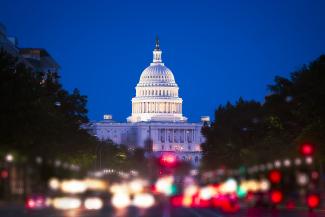Take Advantage of Federal Funding Increases

After years of stagnation, Congress has taken exemplary bipartisan action toward reinstating our country’s commitment to science and reinvigorating our investment in research and development. This year, Congress came together to reach a bipartisan Fiscal Year 2018 omnibus appropriation agreement that provides investment to research programs at NSF, NIH, DOE, USDA, NASA, DOD and other key agencies. Below, we’ve highlighted a few details of the funding increases. Please consider taking advantage of getting your best ideas submitted to these agencies to be able to compete for these and future research funds. And remember, the Office of Research is here to help you develop, prepare, submit, receive and implement your research. Please share this information widely.
Notable Agency Increases:
Department of Energy (DOE): Within the Office of Science, every research program received an increase of at least 10 percent, with particular boosts for advanced computing and fusion energy research. U.S. contributions to the international ITER fusion project more than doubled to $122 million. On the technology front, ARPA-E was saved from elimination. DOE's Energy Innovation Hubs, Energy Frontier Research Centers, and public-private manufacturing innovation institutes were all preserved.
National Institutes of Health (NIH): Every individual institute received a roughly five percent increase above FY 2017 funding at minimum. Congress also directed an additional $414 million to the Institute on Aging for Alzheimer's research, and an additional $500 million for opioid research within the institutes focusing on drug abuse (NIDA) and neurology (NINDS). The BRAIN Initiative, the Cancer Moonshot, and the Precision Medicine Initiative also received the funding mandated by the 21st Century Cures Act.
National Science Foundation (NSF): The core Research & Related Activities were boosted by $301 million (5 percent). Appropriators noted that “this strong investment in basic research reflects the Congress’ growing concern that China and other competitors are outpacing the United States in terms of research spending.” The omnibus also provided funding for the construction of three oceanographic research vessels, as requested by the Senate. NSF’s Education Directorate saw a modest 2.5 percent plus-up.
National Aeronautics and Space Administration (NASA):NASA received a $1.1 billion boost above FY 2017 enacted. In the end, Congress rejected the Administration’s proposed elimination of several earth science missions, including OCO-3, CLARREO-Pathfinder, and DSCOVR; overall Earth Science funding remained flat. Meanwhile, Planetary Science was given a substantial $382 million or 20.7 percent boost. Congress granted $595 million for the Europa mission to Jupiter, including both the clipper and lander components requested by the House. Both the Space Launch System (SLS) and Orion Crew Vehicle remained equal to FY 2017 enacted levels. NASA’s Education Directorate escaped the President’s proposed termination.
National Institute of Standards and Technology(NIST):Lab programs increased by 5 percent, with legislators rejecting the Administration's proposed terminations. Congress also rebuffed the Administration’s requested elimination of the Hollings Manufacturing Extension Partnership (MEP). NIST research facilities construction funding nearly tripled, driving the overall increase for the agency.
National Oceanic and Atmospheric Administration (NOAA): Within the agency's principal research arm, the Office of Oceanic and Atmospheric Research (OAR), climate research was flat-funded, as opposed to the House and Administration’s recommended cuts. Additionally, the omnibus included $419 million for the Polar Follow-on mission, which was subject to deep funding reductions under last year’s request.
U.S. Geological Survey: The omnibus preserved funding for the agency’s eight climate science centers; the White House had proposed cutting their number in half to four. Congress also maintained funding for the continued development of the earthquake and volcano early warning systems, both of which the Administration had slated for elimination.
Environmental Protection Agency (EPA): The agencyescaped the President’s proposed $2.5 billion cut and remained flat-funded at the previous year’s enacted level. Core research missions within EPA’s Science & Technology (S&T) account would see corresponding flat budgets.
Further budget details may be found at:
https://www.aaas.org/news/omnibus-would-provide-largest-research-increase-nearly-decade


